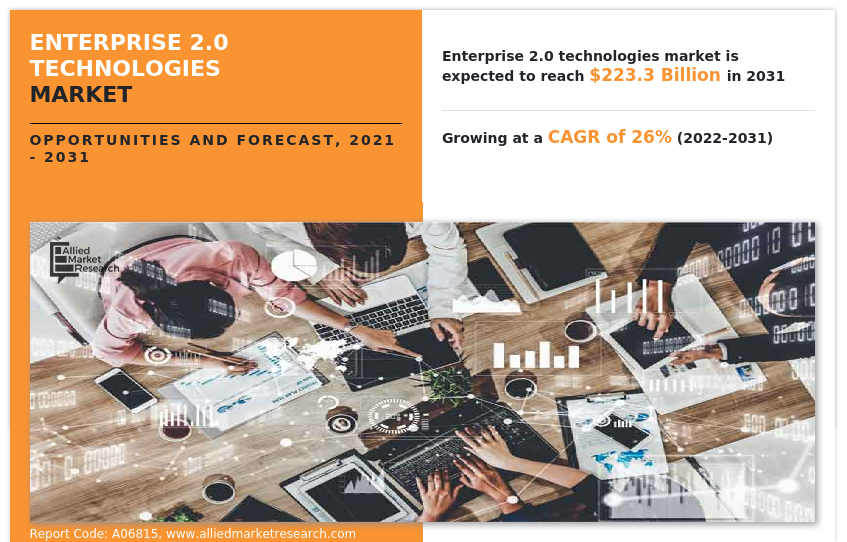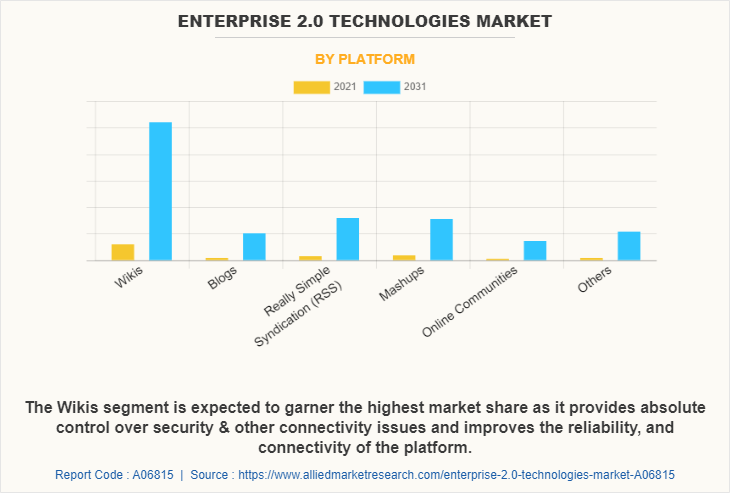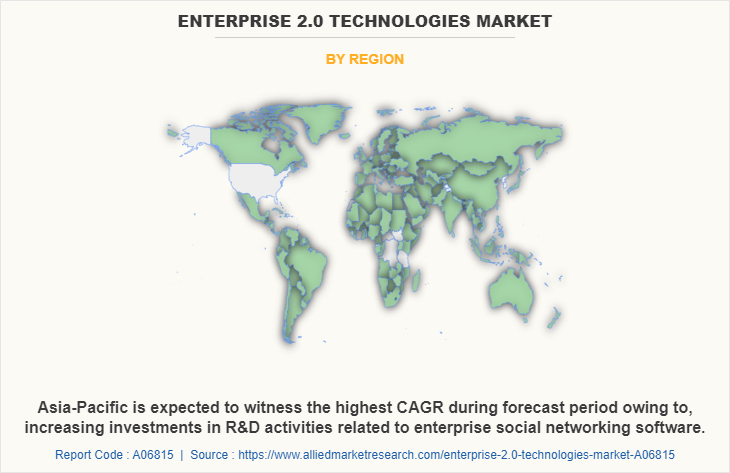Enterprise 2.0 Technologies Market Statistics, 2031
The global enterprise 2.0 technologies market was valued at $22.6 billion in 2021, and is projected to reach $223.3 billion by 2031, growing at a CAGR of 26% from 2022 to 2031.
Rise in awareness about benefits of enterprise 2.0 and the rising penetration of smartphones and the internet boost the growth of the global enterprise 2.0 technologies market. In addition, increasing trends in online shopping positively impact the growth of the market. However, the risk of security incidents on networks and lack of technical proficiency, and lack of awareness hampers the enterprise 2.0 technologies market growth. On the contrary, the increase in technological advancement is expected to offer remunerative opportunities for expansion during the enterprise 2.0 technologies industry forecast.

Enterprise 2.0 technologies are capable of improving external and internal business processes like product innovation, marketing and communication with suppliers and customers. These technologies ensure seamless information sharing among stakeholders, staff and clients to boost innovation, efficiency and productivity. Organizations are integrating enterprise 2.0 technologies and communication strategies to foster communication, ensure access to desired knowledge and expedite business processes. The enterprise 2.0 technologies market is segmented into Platform, Enterprise Size and Industry Vertical.
Segment Review:
The Enterprise 2.0 Technologies market is segmented on the basis of by platform, enterprise size, industry vertical, and region. On the basis of the platform, the market is categorized into wikis, blogs, really simple syndication (RSS), mashups, online communities, and others. On the basis of enterprise size, the market is bifurcated into large enterprises and SMEs. By industry vertical, it is classified into IT and Telecom, BFSI, manufacturing, healthcare, and others. By region, the market is analyzed across North America, Europe, Asia-Pacific, and LAMEA.
In terms of platform, the wikis segment holds the highest enterprise 2.0 technologies market share as it provides organizations to have absolute control over security & other connectivity issues and improves the scalability, speed, reliability, and connectivity of organizations. However, the online communities segment is expected to grow at the highest rate during the forecast period as it facilitates allowed users to easily publish content online and to connect and network.

Region-wise, the enterprise 2.0 technologies market size was dominated by North America in 2021 and is expected to retain its position during the forecast period, owing to rise in adoption of AI, big data, and other analytics technology by enterprises for increasing their production and enhancing their market share. However, Asia-Pacific is expected to witness significant growth during the forecast period, owing to the rise in enterprise 2.0 technologies technology investment.

The key players that operate in the Enterprise 2.0 Technologies market are Avaya Inc, CafeX Communications Inc, Cisco System Inc, Dell Inc, Enghouse Systems., IBM Corporation, Microsoft Corporation, Oracle Corporation, SAP SE, and Vonage Holdings Corp (Telefonaktiebolaget LM Ericsson). These players have adopted various strategies to increase their market penetration and strengthen their position in the enterprise 2.0 technologies industry.
Top Impacting Factors:
Rise in awareness about benefits of enterprise 2.0
Rise in awareness about benefits of enterprise 2.0 that includes increase in productivity, improved collaboration. In addition, increase in sharing knowledge about wed enterprise 2.0 technology leads to work reduction and encourages participation which drives the growth of the market. Moreover, it has a greater degree of congruence though between both the groups on the perceived benefits of Enterprise 2.0 on knowledge management and organizational outcomes.
Furthermore, Enterprise 2.0 implementations generally use a combination of social software and collaborative technologies like blogs, RSS, Social bookmarking, social networking and wikis. For instance, in March 2022, Nvidia launched AI Enterprise 2.1 the latest update of enterprise 2.0 technology the vendor's cloud-native suite that enables enterprises to run AI systems and tools on the VMware vSphere platform. Moreover, Enterprise 2.0 supports every major data center and cloud platform, including bare-metal servers, virtualized infrastructure and CPU-only systems, according to Nvidia. The suite also now supports Red Hat OpenShift.
Rising penetration of smartphones and the internet
Rising smartphone penetration and the internet usage across countries such as China, India, U.S, and others owing to the increasing availability of high-end features and high consumer disposable income. Furthermore, with the low tariff rates and developments in network infrastructures, Internet penetration is also witnessing a rise resulting in increased consumption of Internet-based services such as social media, web applications, and online portals. In addition, smartphones and the Internet provide easy access to enterprise 2.0 tools and technologies for easy collaboration and communication. Thus, the increasing penetration of smartphones and the Internet is driving the growth of enterprise 2.0 technologies market.
Digital Capabilities:
Enterprise 2.0 technologies is a web-based environment that boosts business communication and business-decision making. Newer technologies such as enterprise 2.0 technologies serve to streamline processes that help larger attain organizational goals. In addition, Enterprise 2.0 implementations generally use a combination of social software and collaborative technologies like blogs, RSS, Social bookmarking, social networking, and wikis. AI in Enterprise 2.0 leverages sophisticated technology platforms and packaged solutions that streamline, simplify, and accelerate AI-driven innovation.
Moreover, cloud computing supports Web 2.0 applications by allowing them to demand access to a shared pool of computing resourcing. It includes social and networked modifications to corporate intranets and other classic software platforms used by large companies to organize their communication. In contrast to traditional enterprise software, which imposes structure prior to use, enterprise social software tends to encourage use prior to providing structure.
Key Benefits:
Enterprise 2.0 tools make it easier to share and organize information. Tagging and rating provide a straightforward way to find content and make judgments about what to look at. Blogs and wikis are natural collaboration and communication platforms. Social network tools help staff find the right individual or group of people. Enterprise 2.0 has the potential to provide knowledge and content management in a surprisingly cheap and easy fashion using Web-based tools. Moreover, Enterprise 2.0 removes the size and complexity of earlier systems. It doesn’t need experts such as systems analysts and consultants to make these systems work and to maintain. Unlike most corporate initiatives, Enterprise 2.0 tools, at least in their current incarnation, are not expensive to implement.
Furthermore, it also provides new avenues to open up a conversation with partners, suppliers or customers. Communication flows both ways, enabling to share information and ideas. With these technologies, there is an option to ask customers for pictures or videos using products in interesting ways and thus build brand equity with customer base or it helps to share information with partners who are working on a project with company. Companies can easily start a blog for a specific product category, enabling a small niche of market to communicate, a process that would have been much more difficult and expensive using earlier Web tools.
In addition, these tools are internet tools that allow the user to go beyond just receiving information through the web. The user is expected to interact and create content with others. Social media sites such as Facebook and Twitter are examples of Web 2.0 tools. In addition, with further growth in investment across the world and the rise in demand for enterprise 2.0 technologies, various companies have expanded their current product portfolio with increased diversification among customers.
For instance, in September 2022, Oracle Corporation launched standalone Process Automation, as well as the next iteration of Oracle Integration 3 Oracle Integration is an enterprise connectivity and automation platform for quickly modernizing applications, business processes, APIs, and data. Developers and cloud architects can connect SaaS and on-premises applications six times faster with a visual development experience, prebuilt integrations, and embedded best practices. with further growth in demand across the world and the rise in adoption of enterprise 2.0 technologies, various companies have partnered to increase diversification among customers. For instance, in January 2021, IBM corporation partnered with telephonic help to accelerate the modernization of application estates, while also letting them choose whether to run their workloads in on-premise or cloud-based setups.
Government Regulations:
All well-governed IT industries should be able to demonstrate due diligence to ensure regulatory compliance in applicable fields, including IT. Organizations are adopting enterprise 2.0 technologies to manage, store, and extract relevant and useful information from the data stored and it is logistical and legal challenges along with the expected benefits of using social collaboration tools. Governments of many countries help to safeguard data privacy. For instance, in January 2020, the government of California launched Consumer Privacy Act, and additional governments across the world formalized requirements for how businesses can collect data from visitors on their digital products. As a result, marketers are having to do more personalization with less personal data.
In addition, federal and state governments are improving their track plans for various privacy laws, which are applicable for data that participate in their operations. For instance, the Massachusetts Data Security regulations are majorly focused on security purpose and increasing the privacy of big data analytics. Europe is set to take the advantage of AI for providing data protection facilities to different organizations. For instance, the European Government adopted the new General Data Protection Regulation (GDPR). The act seeks to regulate the collection, storage, and processing of information about individuals. The key aim of GDPR is to protect critical data of consumers of the European nation.
Moreover, organizations are adopting analytical software to deal with applying advanced technologies like artificial intelligence (AI), Machine Learning (ML) to automate processes and augmented human activity. For instance, California’s Online Protection Privacy Act provides explicit privacy rights and allows users to know how their information will be used in the future. Furthermore, the cloud security regulations are strongly adhered by all AI service providers to operate as global service providers, for instance, the U.S. security regulation is mandatory to be adhered by majority of players located in this country.
Key Benefits for Stakeholders:
- The study provides an in-depth analysis of the global enterprise 2.0 technologies market forecast along with current & future trends to explain the imminent investment pockets.
- Information about key drivers, restraints, & opportunities and their impact analysis on global enterprise 2.0 technologies market trends is provided in the report.
- The Porter’s five forces analysis illustrates the potency of the buyers and suppliers operating in the industry.
- The enterprise 2.0 technologies market analysis from 2022 to 2031 is provided to determine the market potential.
Enterprise 2.0 Technologies Market Report Highlights
| Aspects | Details |
| Market Size By 2031 | USD 223.3 billion |
| Growth Rate | CAGR of 26% |
| Forecast period | 2021 - 2031 |
| Report Pages | 265 |
| By Platform |
|
| By Enterprise Size |
|
| By Industry Vertical |
|
| By Region |
|
| Key Market Players | Dell Inc., Vonage Holdings Corp., Microsoft Corporation, IBM CORPORATION, SAP SE, enghouse systems, CafeX Communications Inc, Cisco Systems, Inc., Oracle Corporation, Avaya Inc |
Analyst Review
Enterprise Information Technology (IT) is a technology in which digital and data-related resources are used by an organization to enable business processes, ensure security, and maintain critical information. Enterprise 2.0 facilitates the use of process automation software programs or applications that can be integrated with other systems for decision-making purposes using internet technologies. Digital resources and data are used to optimize business activities in organizations.
The global enterprise 2.0 technologies market is expected to register high growth due to growing demand for protecting data leakage and breaches are expected to drive industry growth. Thus, increase in adoption of enterprise 2.0 technologies, owing to its security is one of the most significant factors driving the growth of the market. With surge in demand for enterprise 2.0 technologies, various companies have established alliances to increase their capabilities. For instance, in October 2022, Accenture partnered with Atlassian to help organizations drive more value from technology investments, improve customer and employee experiences, embrace change and create new business value with enterprise agility services.
In addition, with further growth in investment across the world and the rise in demand for enterprise 2.0 technologies, various companies have expanded their current product portfolio with increased diversification among customers. For instance, in July 2021, Attivo Networks®, the leader in identity detection and response, launched Cloud Infrastructure Entitlement Management (CIEM) solution. The IDEntitleX is designed to deliver visibility and reduce the attack surface for identities and entitlements in the cloud. With this new product introduction, Attivo becomes the only solution of its kind to provide end-to-end analysis of identity and entitlement exposures and risks on endpoints, Active Directory (AD), and the cloud.
Moreover, with the increase in competition, major market players have started acquisition companies to expand their market penetration and reach. For instance, in January 2020, Enghouse Systems Limited acquired Dialogic Group to strengthen its position in the enterprise video and unified communications market segment by adding rich multi-media processing applications and capabilities.
The Enterprise 2.0 Technologies market is estimated to grow at a CAGR of 27.1% from 2022 to 2031.
The Enterprise 2.0 Technologies market is projected to reach $ 24,000.37 million by 2031.
Rise in awareness about benefits of enterprise 2.0 and the rising penetration of smartphones and the internet boost the growth of the global enterprise 2.0 technologies market. In addition, increasing trends in online shopping positively impact the growth of the market.
The key players profiled in the report include Allure Security Technology, Inc, Attivo Networks, Inc, Acalvio, CYBERTRAP Software Gmbh, CounterCraft, Fidelis Cybersecurity, Guardicore Ltd, Illusive Networks, LogRhythm, Inc, Minerva Labs, PacketViper, Rapid7, Smokescreen Technologies, Inc, TopSpin Security, Trapx Security, vArmour, and WatchGuard Technologies.
The key growth strategies of Enterprise 2.0 Technologies market players include product portfolio expansion, mergers & acquisitions, agreements, geographical expansion, and collaborations.
Loading Table Of Content...



